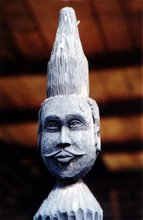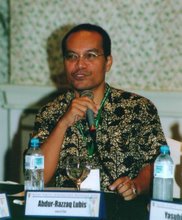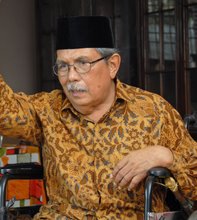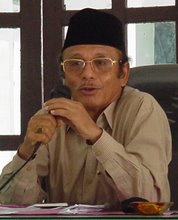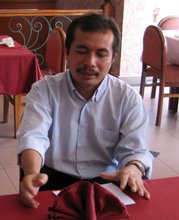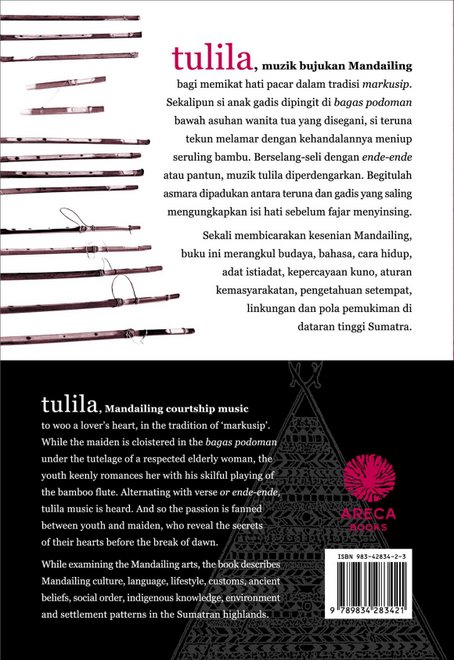
Foto Khoo Salma Nasution
JMBRAS Vol. LXXVII Part 2, 2004
RAJAH BILAH AND THE MANDAILINGS IN PERAK: 1875-1911
by ABDUR-RAZZAQ LUBIS and KHOO SALMA NASUTION
Kuala Lumpur: MBRAS Monograph No. 35, 2003.
Illus, maps biblio, index, hard cover; ISBN 967-9948-31-5
The flow of migrants from Sumatra and other parts of Indonesia in the nineteenth century enriched Malay culture in the Malay Peninsula with distinctive new elements. The assimilation of the twentieth century had diminished but not extinguished these traditions. In this monograph, we have a welcome and perhaps overdue study of the Mandailing settlements in the Kinta Valley by author (Abdur-Razzaq) who is descended from Rajah Bilah.
Padri wars and Dutch economic policy drove Mandailing pioneers from central Sumatra to seek a better life, first in Pahang and Selangor, but disturbances there brought them in the mid-1870s to Perak, at Slim, and finally to the Kinta Valley. Their arrival marked the end of the adventurous career of Rajah Asal and the succession to traditional leadership of his nephew, Rajah Bilah, the central figure of this study.
At the outset, the Mandailing settlers mined tin, but by the 1890s they had lost out to the phenomenal expansion of Chinese mining in the Kinta Valley. As traders and agriculturalists, they soldiered on until the early twentieth century brought real prosperity in developing rubber smalholdings. It is a many-sided and very informative picture, seen through the experiences of Rajah Bilah and his kinsmen and associates. Traditional leadership and lifestyle adapted to a new environment of colonial government and capitalist economy. The British administrators of Kinta came to value this tough, industrious community, and they recognized in Rajah Bilah, a long-serving (1882-1909) penghulu of Papan (near the modern Ipoh), an outstanding personality.
It is closely woven story in which the warp is the ongoing narratives of activities, personal and collective, and the weft in found in the ties of authority and kinship within the Mandailing settlements of Papan and nearby villages. The very detailed account of Malay mining techniques is set within the context of constrains, such as forest and soil conservation policies and fluctuating prices. The massive Chinese influx of the 1880s brought disorder in which Mandailing leaders gave useful support to the British administration. As Rajah Bilah’s mining ventures became unprofitable, he sold out but augmented his commercial and property income with an increasing stipend (including commission on revenue collected) as penghulu. In that capacity, he sat in court to exercise jurisdiction over other Asian communities, and one notes the amicable inter-ethnic relations of that time. Islam – including the building of mosques and the pilgrimage to Mecca – is also an important element in the story. The latter part of the book has chapters on the careers of a number of other Mandailing leaders with whom Rajah Bilah was associated and related.
In compiling their story, the authors have ranged widely over sources that include out-of-way records of mining in Perak, archives, and oral tradition obtained from the elderly in the Mandailing homeland as well as in Perak. But the centerpiece of this social history is the collection of Jawi Malay letters and other documents accumulated by Rajah Bilah, that are unique of their kind. These are known as the ‘Penghulu Papers’ and are lodged in the Rumah Besar built at Papan by Rajah Bilah. Ostensibly a residence, the Rumah Besar was built to serve the Mandailing community as a place of assembly and celebration. Although changing economic circumstances dispersed the Mandailings from Papan later in the nineteenth century, the Rumah Besar and nearby mosque still stand.
It would be interesting to know whose hand actually wrote the more personal of these Malay documents. The Mandailing leaders seem to have been literate (in some instances, residence at Mecca had made them learned in Islam). Government officials, including penghulu, had clerks whose task it was to write leters. But one can visualize discussion between correspondent and scribe, perhaps a professional ‘Malay writer’, as to what should be said. The letters, even brief official missives, open with the conventional ‘compliments’ of a religious nature, and the wrieter of the letter defines his status, usually subordinate, by the use of the terms such as ‘anakanda’ (child) for himself and ‘kakanda’ (elder) of the addressee. Rajah Bilah is usually stled ‘Engku’ (Your Highness). If the letter seeks some help from him, the approach to the subject is, as convention requires oblique, and sometimes veiled in periphrasis. It is a style that reflects the conventional courtesies of the time.
The book reproduces in facsimile a considerable number of these Malay documents from the Penghulu Papers, together with English translations that are literal rather than colloquial but give the flavour of the original. Many are letters written to Rajah Bilah by the British officials with whom he worked. Others are letters from business associates, including some Chinese, and yet others are family communications on personal matters. In addition, the authors use unpublished Malay biographies, quoted in the text, notably the history of Rajah Asal and his descendants written in 1934 by Raja Haji Muhammad Ya’qub, son and successor in office of Rajah Bilah. There are also a number of photographs, some of them the particular contribution of Khoo Salma Nasution as joint author with her husband. In reading this material, the substance of which is skillfully worked into the main text, one has a vivid impression of the lives and personalities of Rajah Bilah and others. In a technical sense, this is a case study of a particular group at a specific place and time. It is also representative of the wider Malay society in the formative period of the late nineteenth century, when swords were being beaten if not into ploughshares then into parangs which cleared the land and created homesteads where there were none before.
The authors, the Toyota Foundation, which give financial support, and the Society all deserve our thanks for the publication of this excellent monograph.
Woodford Green J. M. Gullick
RAJAH BILAH AND THE MANDAILINGS IN PERAK: 1875-1911
by ABDUR-RAZZAQ LUBIS and KHOO SALMA NASUTION
Kuala Lumpur: MBRAS Monograph No. 35, 2003.
Illus, maps biblio, index, hard cover; ISBN 967-9948-31-5
The flow of migrants from Sumatra and other parts of Indonesia in the nineteenth century enriched Malay culture in the Malay Peninsula with distinctive new elements. The assimilation of the twentieth century had diminished but not extinguished these traditions. In this monograph, we have a welcome and perhaps overdue study of the Mandailing settlements in the Kinta Valley by author (Abdur-Razzaq) who is descended from Rajah Bilah.
Padri wars and Dutch economic policy drove Mandailing pioneers from central Sumatra to seek a better life, first in Pahang and Selangor, but disturbances there brought them in the mid-1870s to Perak, at Slim, and finally to the Kinta Valley. Their arrival marked the end of the adventurous career of Rajah Asal and the succession to traditional leadership of his nephew, Rajah Bilah, the central figure of this study.
At the outset, the Mandailing settlers mined tin, but by the 1890s they had lost out to the phenomenal expansion of Chinese mining in the Kinta Valley. As traders and agriculturalists, they soldiered on until the early twentieth century brought real prosperity in developing rubber smalholdings. It is a many-sided and very informative picture, seen through the experiences of Rajah Bilah and his kinsmen and associates. Traditional leadership and lifestyle adapted to a new environment of colonial government and capitalist economy. The British administrators of Kinta came to value this tough, industrious community, and they recognized in Rajah Bilah, a long-serving (1882-1909) penghulu of Papan (near the modern Ipoh), an outstanding personality.
It is closely woven story in which the warp is the ongoing narratives of activities, personal and collective, and the weft in found in the ties of authority and kinship within the Mandailing settlements of Papan and nearby villages. The very detailed account of Malay mining techniques is set within the context of constrains, such as forest and soil conservation policies and fluctuating prices. The massive Chinese influx of the 1880s brought disorder in which Mandailing leaders gave useful support to the British administration. As Rajah Bilah’s mining ventures became unprofitable, he sold out but augmented his commercial and property income with an increasing stipend (including commission on revenue collected) as penghulu. In that capacity, he sat in court to exercise jurisdiction over other Asian communities, and one notes the amicable inter-ethnic relations of that time. Islam – including the building of mosques and the pilgrimage to Mecca – is also an important element in the story. The latter part of the book has chapters on the careers of a number of other Mandailing leaders with whom Rajah Bilah was associated and related.
In compiling their story, the authors have ranged widely over sources that include out-of-way records of mining in Perak, archives, and oral tradition obtained from the elderly in the Mandailing homeland as well as in Perak. But the centerpiece of this social history is the collection of Jawi Malay letters and other documents accumulated by Rajah Bilah, that are unique of their kind. These are known as the ‘Penghulu Papers’ and are lodged in the Rumah Besar built at Papan by Rajah Bilah. Ostensibly a residence, the Rumah Besar was built to serve the Mandailing community as a place of assembly and celebration. Although changing economic circumstances dispersed the Mandailings from Papan later in the nineteenth century, the Rumah Besar and nearby mosque still stand.
It would be interesting to know whose hand actually wrote the more personal of these Malay documents. The Mandailing leaders seem to have been literate (in some instances, residence at Mecca had made them learned in Islam). Government officials, including penghulu, had clerks whose task it was to write leters. But one can visualize discussion between correspondent and scribe, perhaps a professional ‘Malay writer’, as to what should be said. The letters, even brief official missives, open with the conventional ‘compliments’ of a religious nature, and the wrieter of the letter defines his status, usually subordinate, by the use of the terms such as ‘anakanda’ (child) for himself and ‘kakanda’ (elder) of the addressee. Rajah Bilah is usually stled ‘Engku’ (Your Highness). If the letter seeks some help from him, the approach to the subject is, as convention requires oblique, and sometimes veiled in periphrasis. It is a style that reflects the conventional courtesies of the time.
The book reproduces in facsimile a considerable number of these Malay documents from the Penghulu Papers, together with English translations that are literal rather than colloquial but give the flavour of the original. Many are letters written to Rajah Bilah by the British officials with whom he worked. Others are letters from business associates, including some Chinese, and yet others are family communications on personal matters. In addition, the authors use unpublished Malay biographies, quoted in the text, notably the history of Rajah Asal and his descendants written in 1934 by Raja Haji Muhammad Ya’qub, son and successor in office of Rajah Bilah. There are also a number of photographs, some of them the particular contribution of Khoo Salma Nasution as joint author with her husband. In reading this material, the substance of which is skillfully worked into the main text, one has a vivid impression of the lives and personalities of Rajah Bilah and others. In a technical sense, this is a case study of a particular group at a specific place and time. It is also representative of the wider Malay society in the formative period of the late nineteenth century, when swords were being beaten if not into ploughshares then into parangs which cleared the land and created homesteads where there were none before.
The authors, the Toyota Foundation, which give financial support, and the Society all deserve our thanks for the publication of this excellent monograph.
Woodford Green J. M. Gullick
